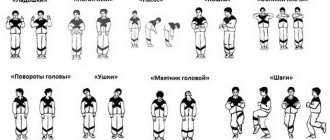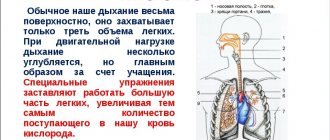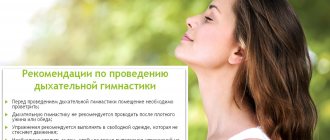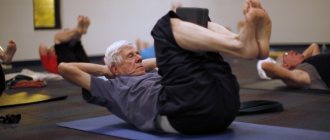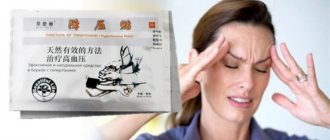Cardiovascular disease remains a major cause of death from heart attack and stroke worldwide. The global medical community is developing more and more new methods of drug therapy. The Ministry of Health has developed standards for the provision of medical care at different stages.
In addition to pharmacological agents, hypertensive patients actively resort to the use of traditional medicine recipes and herbal medicine. The treatment complex includes various types of massage, physiotherapy, acupuncture, spa treatment, and psychotherapy. Physical therapy made its contribution. Let's discuss aspects of treating hypertension using the Bubnovsky method.
The importance of gymnastic exercises for normalizing blood pressure
It has been scientifically proven that the heart is the first to suffer from prolonged inactivity of skeletal muscles. For a long time, this fact was explained by the fact that at the time of contraction of muscle tissue, ventilation of the lungs increased, metabolic processes accelerated, and the supply of oxygen to all organs and systems of the body, including the heart, improved. Oddly enough, this theory does not explain the influence of movement on the process of normalizing pressure. And all because completely different mechanisms are involved in it.
Until recently, it was believed that muscles were only blood consumers, which, at the moment of intense contraction, forced the heart to work hard. But it turned out that this concept is erroneous, and muscle inaction has a detrimental effect not only on a healthy, but also on a diseased heart. Clinical studies have shown that in the human body there are extracardiac circulatory mechanisms, which include the patient’s muscles. It is they who, working hard, help the heart pump blood through all the vessels of the body, thereby normalizing blood pressure.
Therefore, the statement that doing gymnastics with high blood pressure is dangerous is erroneous, and the consequences of doing it can only worsen the already problematic functioning of the cardiovascular system. It is on this theory that the unique treatment of hypertension according to Bubnovsky is based, who, instead of pills and injections for blood pressure, invites a person to use the hidden resources of his body.
The essence of the Bubnovsky method
Sergei Mikhailovich Bubnovsky developed a program for the treatment of hypertension without the use of drugs
First, a few words about who Dr. Bubnovsky is.
Sergei Mikhailovich Bubnovsky kinesiotherapist, professor, doctor of medical sciences, author of books and creator of medical centers for the treatment of diseases of the spine and joints, or rather their restoration, without the use of operations and painkillers. Everything new is well forgotten old. The foundations of kinesiology and kinesiotherapy come from Ancient Greece and Ancient Rome. Long before our era, they knew methods of relieving pain using special exercises for various muscle groups and hydromassage techniques. In ancient China, many diseases were treated with correct movements and breathing exercises.
Until the 17-18th century, these developments were consigned to oblivion, especially in European countries. The renewed interest in them concerned mainly rehabilitation with the help of movements for diseases of the musculoskeletal system.
Method S.M. Bubnovsky has been patented, his books have been translated into many languages of the world, his numerous students are developing the direction of rehabilitation not only for diseases of the musculoskeletal system, but also for somatic and internal diseases.
The essence of Bubnovsky’s method is that by working out his body on simulators or performing physical complexes even in volumes that are negligibly small in relation to normal loads, a patient who has pathological impulses from diseased organs (heart, blood vessels, lungs), which prevents him from performing healthy loads, does not only loses fear of movement. This triggers the mechanisms of self-regulation and self-healing, which is an anti-stress effect. All systems and subsystems of the body are included in the movement, their work is synchronized.
Blood flow in the diseased organ gradually improves, muscle activity helps the heart pump more blood, and this in turn allows you to expand the load and restore the body. In this way, the postulate is realized that muscle tissue is the healing tissue of the body.
Basic techniques for stabilizing pressure
Modern methods of treating hypertension have long been no longer limited to taking antihypertensive drugs. Today, in order to normalize blood pressure, a person also needs to radically change his life, namely: lose excess weight, give up bad habits, review his diet and move as much as possible. But there are also a number of non-standard, but very effective techniques, which include special exercises for lowering blood pressure. The treatment complexes developed by Bubnovsky deserve special attention. Hypertension, in his opinion, should be treated not with pills, but with physical exercises, which help not only get rid of blood pressure problems, but also improve health.
Bubnovsky developed four types of therapeutic exercises for blood pressure:
- aerobic;
- training;
- gentle;
- respiratory.
Every person can perform any set of exercises for blood pressure, and for this he does not need special physical training. At Bubnovsky you can find special programs for reducing blood pressure, which are ideal for pregnant women, the elderly, overweight patients, with varicose veins, as well as patients who have had a heart attack or stroke.
Causes and consequences of pressure surges
For most people, your blood pressure levels may change several times throughout the day. And if these differences are within normal limits and there is a small difference between them, then such a change in pressure does not cause significant harm to health. But it’s a completely different matter when it comes to conditions that are dangerous to humans. Therefore, if sudden pressure surges occur, you should immediately seek help from a specialist.
Only a doctor will help determine the true cause that provoked this condition and tell you how to eliminate it.
Most often, pressure drops occur due to well-known circumstances:
- severe fatigue or stress;
- sudden changes in temperature or atmospheric pressure;
- taking certain groups of medications;
- endocrine diseases;
- hormonal changes in the body;
- pathology of the kidneys and adrenal glands.
As can be seen from the causes of pressure drops, almost all people are at risk. Unfortunately, in many situations you have to deal with the consequences of unstable pressure, and not with its cause. And here it is precisely the methods of physical therapy that can help both in the prevention of normalization of pressure and in its treatment.
Exercises according to Bubnovsky for hypertension
To get rid of pressure surges, you need to do two simple exercises by Dr. Bubnovsky at least once a day, which affect the speed and volume of blood circulation, improve vascular tone and, accordingly, help to forget about blood pressure problems once and for all. Such exercises include:
- Walking. This type of aerobic exercise is best done in the fresh air for 20-25 minutes a day. Each subsequent workout increases both in time and distance. In special cases, you can walk at home, alternating different types of steps every two minutes. During exercise, you need to monitor your breathing and control your pulse, which should not be higher than 140 beats per minute.
- Squats. Feet shoulder-width apart, back straight and shoulders back. During your first workouts, you don’t need to lower your hips below your knees. People who have difficulty doing squats can rely on any support when lifting. You can perform ten exercises in one approach, and there should be at least five such approaches per day.
- Push ups. Each patient performs this type of exercise taking into account his weight and physical fitness. Anyone who feels strong can do push-ups. Well, those who have physical health problems can benefit from exercises, for example, resting their knees on the floor, or doing push-ups not on the floor, but on a bed or chair. In one approach you need to do 5-10 push-ups.
- Press forward. For this exercise, you must have a simulator or a large elastic rubber ball. It must be performed in a half-sitting position, leaning either against the back of the machine or against the ball. You need to take the weights in your hands and move them forward with each exercise. The number of presses in one approach can vary from 10 to 25 times.
- Press. This type of exercise is suitable for absolutely all patients. It is performed in a lying position. You need to hold on to any fixed support with your hands. Depending on the physical condition of the patient, the legs can be either free or fixed to the simulator. As you exhale, you need to pull your knees towards your stomach.
Patients who have problems with joints need to perform all pressure exercises in a simplified or lightweight form, that is, in water.
Important! Bubnovsky exercises for hypertension are indicated only for people with I and II degrees of arterial hypertension. And for patients with severe hypertension, the simplest exercises are specially developed to help restore movement disorders.
Useful tips when doing gymnastics
Some useful recommendations before and during gymnastics:
- Gymnastics should be performed to the end. Even if you feel an improvement, it is not recommended to quit halfway through.
- You need to start with small exercises with minimal loads. Sudden loads can only do harm.
- After the first exercises, nausea, pain in the head and surges in blood pressure may occur. There is no need to worry, this is the body’s reaction to physical activity.
- Always follow the correct technique for performing gymnastics. The wrong exercises are not effective.
- Do not try to increase the number of approaches without consulting a specialist.
- Every morning you need to take a cool bath or shower. Dousing is acceptable and it is advisable to wet your head. But if you have high blood pressure, dousing yourself with very cold water is prohibited; this can cause a strong surge in pressure.
- Every morning, squat 10 times, keeping your back straight. This will normalize blood flow. You can also do 5-6 push-ups (from the floor or on an elevated surface).
- The duration of physical exercise should not exceed 20 minutes.
- After completing Bubnovsky’s gymnastic complex, it would be a good idea to drink water or tea with mint. This will help normalize blood pressure and not cause vascular dehydration.
- All exercises should be gradual, slow, free and without harshness. Maintain proper breathing; deep, slow breaths help better enrich cells with oxygen. Holding your breath is not recommended.
- If you want to exercise outdoors, remember that you cannot exercise in the cold or heat.
- People who are overweight must undergo a special “load” test, which will show how much time to spend on exercise and what kind of load is appropriate.
- During gymnastics, you should monitor your diet. Eat in small portions, avoid overeating.
- Before and after exercises, try to measure your blood pressure and write down the readings. This will help determine which loads should be reduced.
Gentle workout for high blood pressure
It is known that muscles belong to the extracardiac circulatory mechanism, which is responsible for pressure in the veins and capillaries. And this means that when they stop working fully. Blood circulation is disrupted and the heart has to work with double force. This is why it is so important to prevent muscles from losing their firmness and elasticity. And the most effective method is gentle therapeutic exercises, which can help all people suffering from high blood pressure. Basic exercises include:
- step forward with a shift in the center of gravity;
- emphasis on the wall with your hands, simulating movement without lifting your toe or heel off the floor;
- walking around the room with arms raised and hands moving;
- alternate swings, first with one leg and then with the other.
Important! Before you begin gentle exercises to reduce blood pressure, you need to discuss the exercise program with your doctor.
Possible contraindications
There are the following contraindications to performing gymnastics using the Bubnovsky method:
- The pulse rate should not exceed the permissible norm. The required frequency of blows can be found from the formula: 180 beats minus your current age.
- Physical exercise is contraindicated if:
- cardiovascular failure;
- severe form of hypertension;
- during menstruation;
- during pregnancy, physical exercise should be minimal;
- in periods after a hypertensive crisis.
- It is forbidden to engage in exercise therapy if there is weakness and malaise.
Before carrying out exercise therapy, it is necessary to consult a specialist with an examination and tests. Therefore, you will have a meeting with your doctor and an individual consultation. If you are not confident in your abilities, start training with a specialist first, and then you can do the exercises on your own.
Source: serdce.biz
Breathing exercises for pressure relief
The method of breathing exercises at high pressure is aimed at saturating the brain and heart with sufficient oxygen. This helps speed up metabolic processes, normalizes blood and lymph flow. You need to start with a 10-minute breathing exercise, gradually increasing its duration to one hour a day. Yoga can also reduce blood pressure, especially if used in combination with breathing exercises. Such exercises combine therapeutic movements of the diaphragm, collarbone and ribs, which helps normalize blood pressure and improve well-being.
Easy exercises to consolidate results
Throughout the day, people suffering from high blood pressure can perform simple exercises that help maintain positive results. They are especially relevant for people who are forced to lead a sedentary lifestyle due to sedentary work.
Dr. Bubnovsky recommends getting up and doing 10 squats every 60 minutes. After completing this exercise, you need to drink 10 sips of pure still water.
If possible, it is recommended to repeat some exercises from the breathing exercises complex.
Advantages of treating hypertension according to Bubnovsky
The Bubnovsky method of treating hypertension has a lot of advantages, the main one of which is the ability to minimize or completely eliminate often expensive drug therapy. In other words, Bubnovsky offers exercises that are quite accessible and suitable for everyone, which, in addition to stabilizing blood pressure, help:
- relieve nervous tension;
- increase the body's protective properties;
- strengthen the heart and blood vessels;
- slow down the development of atherosclerosis;
- get rid of chronic fatigue.
To reduce pressure, the patient needs to correctly perform each movement and correctly follow the sequence of exercises. After all, for people suffering from arterial hypertension, one must always remember that correct movement heals, and incorrect movement can only worsen the condition and even provoke a surge in pressure.
How is it different from other methods?
The main distinguishing feature of the method is the absence of drugs. The therapeutic effect is achieved exclusively by the positive effects of physical activity.
The Bubnovsky method is an excellent preventive technique in the fight against high blood pressure. You can perform the exercises in any convenient place, without using special equipment.
The main advantages of the technique:
- Bubnovsky's method is often used in complex therapy of hypertension;
- improving the general condition of the body, increasing the patient’s vitality;
- the functioning of the human immune system is normalized;
- gymnastics helps in the fight against stress and psycho-emotional tension;
- Bubnovsky’s exercises act as a prevention of atherosclerosis of blood vessels;
- the training complex can be performed at any time of the day and in any place, which makes it accessible to absolutely all people;
- the basic principles of a healthy lifestyle enhance the effect of exercise;
- The exercises are chosen so that anyone can do them, even with a very low level of physical fitness.
Gentle gymnastics
Gentle gymnastics is a simplified type of exercise that includes simple actions with less load in the form of steps in place (back/forward), changing the frequency of breathing from the diaphragm, swinging legs, forced muscle tension, raising your arms up, yoga and other exercises.
Therapeutic exercise is what allows our body to cope with the problem without the involvement of drugs, but only by putting stress on the body. Courses of treatment that are treated without medications or with a minimum amount of them have always been valued; Bubnovsky’s technique has become another good example of a favorable load in the treatment of hypertension.
Therapeutic physical culture developed at the intersection of medicine and physical education, so it is often prescribed by doctors to normalize well-being after various diseases, for their treatment and prevention.
The basis of such gymnastics is the well-known truth - movement is life. However, it should be understood that any exercise must be performed in a certain amount and correctly.
Not long ago, Dr. Bubnovsky developed a set of gymnastic exercises for people suffering from hypertension. His technique involves mobilizing the internal reserves of the human body. Gymnastics does not require special physical training; everyone can perform the exercises.
The first exercise in this block is called “Knee Bend”, it is intended to treat high blood pressure, and is performed while lying on your back. The patient is required to:
- bend your knees;
- clench your fingers into a fist.
While performing the exercise, it is important that the muscles are tense at all times. Next, you should straighten your legs and completely relax your body. This exercise is repeated at least 6 times in a row.
Then Dr. Bubnovsky suggests performing “Diaphragm Breathing.” During this exercise, the patient should lie on his back and perform diaphragmatic breathing. Per approach you need to take approximately 5 deep breaths and exhalations.
To “Raise your arms” you also need to lie on your back, raise your arms towards the ceiling, and then pull yourself up, place your limbs behind your head and inhale sharply. At the next stage:
- take the starting position;
- exhale.
For hypertension, it is useful to perform this exercise more than 5 times in a row.
The next exercise is “Muscle Tension.” To perform it correctly, you should lie on your back (on a flat surface), tense your leg muscles well and take a deep breath. Afterwards you will need to completely relax and exhale. Dr. Bubnovsky recommends repeating these steps 3 times in a row.
The last gymnastic exercises of this block are “Alternating tension of the legs and arms”, “Circular movements”. For the first exercise, you should bend your arm so as to touch the shoulder of the same limb with your hand. At the same time, bend the same leg at the knee and take a deep breath (left arm and leg, right arm and leg). Repeat at least 5 times.
The next exercise also requires you to lie on your back. The right leg is raised up and made circular movements, then lowered:
- thoroughly relaxing the leg muscles;
- without holding your breath.
Then similar movements are made with the left foot. It is recommended to do 8 repetitions.
At the end of each session, it is very important to completely relax, this will relieve muscle pain and restore breathing. To clearly see how the proposed complex is performed, you can watch the corresponding video on the Internet.
Hypertension {amp}#8211; not a sentence!
It has long been a well-established opinion that it is impossible to get rid of HYPERTENSION forever. To feel relief, you need to continuously drink expensive pharmaceutical drugs. Is it really? Let's figure out how hypertension is treated here and in Europe.
This complex is a little more complicated, since gymnastics is performed in a standing position. The first lesson is “Step forward”, the sequence of actions is as follows:
- step forward, shifting the center of gravity;
- stretch their arms out in front of them;
- raise their hands up, inhale;
- exhaling, return to their original position.
On the recommendation of Dr. Bubnovsky, the steps are repeated 3 times in a row.
To perform “Wall Support,” your hands are placed on the wall and your body is tilted forward. In this case, you need to depict walking in place, lifting only your heels off the floor. The task is performed 10 times on each leg.
Then you can walk around the room, rhythmically raising your arms up and shaking your hands, and then lower your arms. You need to repeat the movements about 5 times.
At the end they do “Leg Swings”. They stand straight and lower their hands to waist level. After which they swing their right leg (forward and backward), relaxing the limb to such a state that there is a feeling of heaviness. You need to do the movements as many times as possible.
The set of exercises ends with relaxation; a detailed video can be seen on the Internet.
They start practicing with “Walking”, for 2-3 minutes they alternate between different types of walking:
- walking on toes;
- cross step;
- walking on heels;
- side step.
Each type of walking is replaced after 5 steps, making sure that breathing is even.
At the next stage, do gymnastics with your elbows. The lesson is carried out sitting, arms bent at the elbows, placing them at the same level as the chest. After which it is necessary to move the upper limbs back with a sharp movement, taking a breath.
The torso is tilted, the arms are lowered so that they hang down and the hands are near the heels. It is important to ensure that your head is not tilted too low. Repeat at least 3 times in a row, this will be extremely effective exercise therapy for hypertension.
Continue training gymnastics with the “Bicycle” exercise. The patient should sit on a chair and rest his hands on the seat. Then you need to raise your legs, wait a few seconds, inhale and perform 3 movements that imitate riding a bicycle.
After completion, you will need to return to the original position, rest for a few seconds and repeat the task. In total, you need to do at least 5 repetitions.
For hypertension, Dr. Bubnovsky’s gymnastics continues with “Shoulder Movement.” The patient must:
- sit on a chair;
- raise your shoulders, leaving your arms hanging down;
- perform circular movements with your shoulders.
At the end, the arms are lowered and the exercise is repeated at least 5 more times.
“Stand up and sit down” is performed by sitting down on a stool, and positioning the legs in such a way that the feet stand on the same line in front of the person - one in front of the other.
It is necessary to rise from the chair, trying to maintain balance, and then sit down again. It is important to rise as you exhale and sit down as you inhale.
As soon as the entire cycle of exercises is completed, Dr. Bubnovsky recommends taking the so-called coachman pose and simply breathing deeply for at least 2 minutes.
Continue gymnastics with simple walking. You should walk for at least 30 seconds, and it is useful to make different movements with your arms.
When doing the “Torso Turn,” you will need to stand up straight with your feet shoulder-width apart. For hypertension, it is recommended to turn the body, moving your arms to the sides and taking a deep breath. After which they take the starting position again and exhale sharply. Do 4 repetitions on each side (left and right).
Each of the exercises proposed above, despite its simplicity, is quite effective in the treatment of hypertension. However, before starting classes, it would not hurt to consult with your doctor. Perhaps the doctor:
- will suggest replacing any exercises;
- will complement gymnastics with new elements.
If you have hypertension, you can do other exercises. For example, if you squat with a straight back every day, many problems with blood circulation and heart can quickly go away. This recommendation is especially important for those hypertensive patients whose occupation requires them to spend long periods of time sitting (programmers, accountants, designers). It is proposed to practice according to the following scheme:
- do 10 squats;
- drink 10 sips of water.
It doesn’t hurt to make it a rule to do 30 squats after every hour of work. It's good to start your morning with a cool shower or bath. It is quite enough to carry out the procedure for 5 seconds, be sure to plunge headlong. There is an opinion that it is still better to choose a shower, since it breaks up a person’s energy, while a bath, on the contrary, collects it.
It is extremely important to always follow the exercise technique. In this case, the patient can count on rapid recovery of the body and the prevention of some discomfort.
Specifics of pathology and the importance of physical activity
Hypertension is a specific vascular pathology in which excessive activity leads to the development of a crisis and serious consequences. To stabilize the patient’s condition and prevent complications, doctors recommend moderate physical activity.
Concept of GB
With constant exercise under the supervision of a physician, hypertensive patients experience favorable changes in the dynamics of the heart. Due to oxygen saturation, the likelihood of stress and, accordingly, exacerbation of the disease is reduced.
Even a regular walk for an hour promotes the production of special hormones aimed at regulating the functioning of the circulatory system and improves the body's endurance. Over time, the patient notes a decrease in the level of fatigue.
Therapeutic breathing exercises according to Buteyko
Breathing exercises for hypertension, developed by doctor Buteyko, are performed in a dynamic and calm state of the body and generally consist of 3 main stages. Breathing exercises for hypertension according to Buteyko and the technique for performing it are as follows:
The patient takes a deep breath and then holds his breath for 10-12 seconds. At the end of this time, it is necessary to begin taking sharp and not deep breaths through the nose, reminiscent of jerks. Accelerated breathing through the nose continues for 1-2 minutes. Then the person exhales smoothly and slowly, freeing the chest from accumulated carbon dioxide formed after the metabolism of oxygen.
- Holding your breath while walking.
The essence of this element of breathing exercises is that a person who wants to get rid of hypertension, using the Buteyko method, moves around the room at a slow pace, and then takes a deep breath and holds his breath. The nose should be closed with the hand, the oral cavity should also be sealed due to the tight compression of the lip flaps. The patient tries to live as long as possible without additional air flow, using for life only those volumes of oxygen that were last inhaled. After this, stable breathing is restored, and it is held again after 2-3 minutes. The optimal number of repetitions is 4 times in a row throughout the day.
It is performed exclusively in a sitting position, when the abdominal diaphragm is in the most relaxed state. The patient should breathe easily, using only the abdominal muscles. The use of shallow breathing in the treatment of hypertension involves minimal involvement of the chest. Each absorption of the next portion of oxygen occurs without the use of a deep breath. One treatment approach lasts 3-4 minutes. It is recommended to do no more than 3 approaches throughout the day.
Breathing exercises from Dr. Buteyko have a large number of supporters and are actively used not only for the treatment of hypertension, but also other pathologies associated with various dysfunctions of the respiratory system, as well as disruptions in the functioning of the heart.
Other tips
After gymnastics, do not forget to rest. If you are at home, you can lie down for a few minutes with your legs raised high - this will improve blood flow to your heart and brain. It is very important to listen to your feelings.
Daily exercise should not cause you severe pain and dizziness.
Bubnovsky also developed separate gymnastics for the cervical spine. It is known that the most dangerous complication of hypertension is stroke and cerebral hemorrhage. In order to prevent these consequences, you can daily perform circular movements with your head, stretch your neck and chin up. Tilt your head to the sides, trying to reach your shoulder with your ear. These simple manipulations will help get rid of floaters before your eyes, relieve headaches and improve blood flow to the brain.
By performing Bubnovsky's exercises at least once a day, you will significantly speed up your treatment. If you do exercises as a preventive measure, then a disease such as hypertension will never affect you, and you will be able to boast of the impeccable functioning of your heart and blood vessels even in old age.
NORMATEN ® - innovation in the treatment of hypertension in humans
• Eliminates the causes of pressure disorders
• Normalizes blood pressure within 10 minutes after administration
Breathing exercises for hypertension is one of the most common methods of alternative treatment of arterial hypertension and prevention of sudden increases in pressure. In this case, the patient does not need to take a large amount of medications daily, administer intramuscular injections and resort to other therapeutic manipulations that do not always bring positive results. In order to effectively combat the manifestations of hypertension solely by performing special breathing exercises, it is enough just to master therapeutic breathing techniques that strengthen the heart, lungs, blood vessels and saturate the brain tissue with an increased concentration of oxygen molecules. The most popular, proven useful, are breathing exercises for hypertension, which are carried out according to the method of Bubnovsky, Strelnikova and Buteyko. We will consider in detail all these techniques of alternative therapy for hypertension and the correct implementation of recommendations from leading experts in the field of treating diseases of the cardiovascular system using breathing exercises.
There are several sets of health-improving breathing techniques that allow for effective treatment of hypertension with breathing exercises, the regular implementation of which reduces blood pressure to levels that are comfortable for the patient to carry out normal life activities, and also prevents the possible onset of such negative complications as ischemic stroke of the brain, as well as myocardial infarction. Performing breathing exercises is based on alternating inhalations and exhalations, which are performed within a certain time interval. In some cases, a hypertensive patient has to hold his breath and then smoothly exhale the spent oxygen, which has been converted into carbon dioxide as a result of metabolism.
Depending on the type of exercise, breathing exercises are performed in a lying position, sitting, or with your knees tucked to your chest. This method of therapy has virtually no contraindications, except for the presence of concomitant ailments such as bronchial asthma in the acute stage, pulmonary emphysema and congenital heart defects in a person with hypertension. In the latter case, holding your breath can disrupt the stability of the heart rhythm and provoke dysfunction of the valves that allow blood to pass through the great vessels. Even if a person suffers from hypertensive crises for a long period of time, regular performance of these exercises minimizes the need for taking a large number of medications.
The famous scientist and pulmonologist Dr. Bubnovsky developed breathing exercises for hypertension, which combine elements of physical education and breathing exercises. The main goal of this treatment regimen is to use the maximum number of muscle groups and at the same time provide a cardiological load on the heart in order to train it. Breathing exercises for hypertension according to Bubnovsky are as follows:
- The patient lays a blanket or any fabric cape on the floor, and then gets down on all fours.
- The back muscles are relaxed to the maximum extent and the posture is deflected, as far as a person using this treatment technique can do it.
- All emphasis and centralization of body weight is placed on the upper and lower extremities, the muscle fibers of which are kept in good shape. The arching of the back and the period of its complete relaxation lasts at least 3 minutes.
- At the end of the adaptation period, the patient takes a sharp deep breath, holding his breath for 3-4 seconds. After this, a sharp exhalation is performed while simultaneously tensing the back and rounding it into an arc.
- In one approach, a person suffering from hypertension should do at least 25-30 repetitions. It is advisable to perform Bubnovsky’s breathing exercises at a calm pace, observing exclusively the technical side of the exercises. Then a positive therapeutic effect will truly be achieved.
As soon as the breathing part of the workout is completed, the person rises to a vertical position without rest and moves on to the stage of physical activity. The patient takes a wide step with his left leg, bends it halfway and at the same time takes a deep breath. While in this position, you should hold your breath for 5 seconds and then exhale sharply so that there is no oxygen left in the lung cavity. A similar exercise is done using the other leg. The optimal number of repetitions is 7-10 times. Performing these actions daily will take no more than 15-20 minutes of free time.
Advantages and disadvantages
The gymnastics developed by Dr. Bubnovsky are easy to perform. You don't have to constantly visit the gym; you can do simple movements even while sitting at your desk. Charging requires no effort and will not attract unnecessary attention. Simple exercises relieve tension in the veins, strengthen the walls of blood vessels and improve the functioning of the muscles of the lower leg and neck.
Limitations in physical exercise may affect people who have suffered a heart attack or stroke.
Treatment according to Bubnovsky has no contraindications.
Prevention and recommendations
Dr. Bubnovsky suggests familiarizing yourself with some tips and useful recommendations before starting to perform training complexes.
- The therapeutic course must be followed within the recommended time frame and not violate the duration. You should not quit classes when you notice the first improvements in your well-being. Most likely this is a welcome return to the original state.
- In the first stages of training, the load should be minimal. Increasing the severity of classes should occur gradually.
- At the very beginning of therapy, side effects may occur in the form of nausea, vomiting, dizziness or headaches. This is not an indication to stop training.
- It is necessary to strictly follow the technique of performing this or that exercise. Only in this case will they bring the desired result.
- Do not increase the load beyond measure. This will not bring faster results. Most likely, the opposite effect will be achieved in the form of a worsening of the condition.
- Hardening is an integral part of Bubnovsky’s technique. A cool or contrast shower in the morning is mandatory.
- As a morning exercise, it is recommended to do 10 squats and 10 push-ups. This allows blood flow to normalize after a night's sleep.
- After training, it is imperative to drink water.
- During the period of practicing Bubnovsky’s exercises, it is very important to follow the principles of proper balanced nutrition.
- Before and after training, it is necessary to measure the level of pressure in the blood vessels. This will allow you to regulate the degree of physical activity.
Today, there are many alternative treatment options for high blood pressure. One of these is the treatment method of Dr. Bubnovsky. He suggests normalizing blood pressure through exercise.
However, before starting to perform physical complexes, you must consult your doctor.
Source: otgipertonii.ru
Precautionary measures
Like any other method of treatment, Bubnovsky’s physical exercises have a number of contraindications. It is not recommended to perform the proposed complexes in the following cases:
- the patient has severe symptoms of tachycardia;
- insufficient myocardial function was diagnosed;
- the patient has extreme hypertension;
- women are advised to refrain from exercise during menstruation;
- pregnant women can perform exercises only after additional consultation with a doctor and with minimal load;
- It is strictly forbidden to engage in physical exercise during a hypertensive crisis.
Do not neglect the listed contraindications. Despite its apparent simplicity, the exercises have a strong therapeutic effect. If performed incorrectly, they can harm or worsen pathological conditions in the body.
